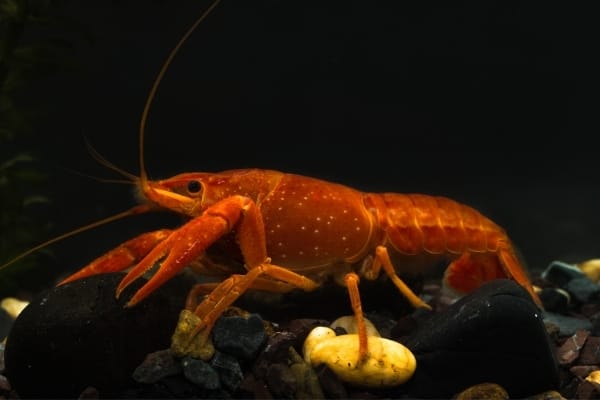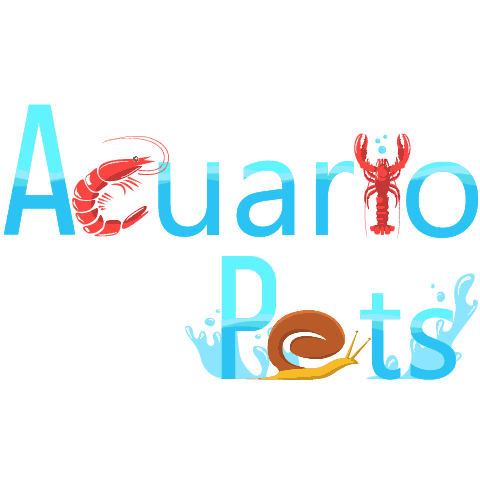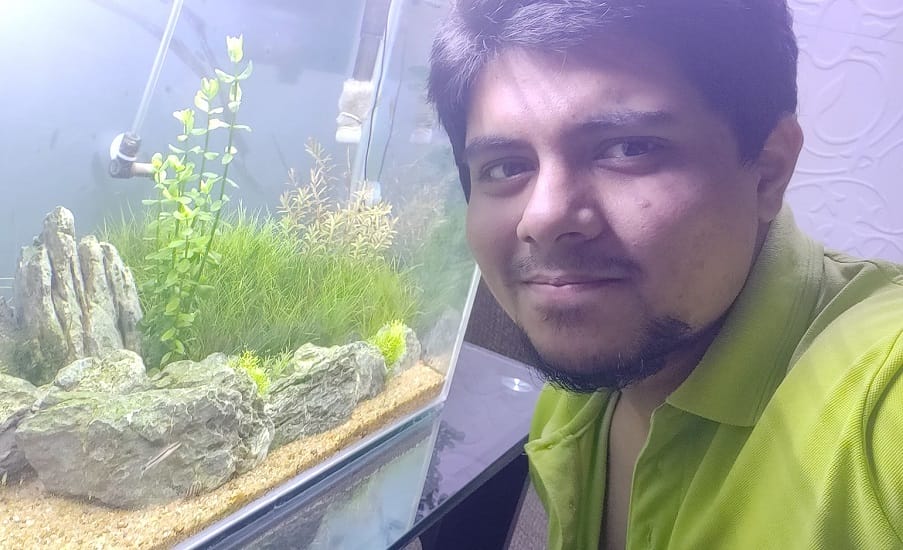How Long Do Crayfish Live?

Do you know wild crayfish species can live much longer than the captive ones? Some wild crayfish species can live 10 times longer than a captive crayfish species. Do you want to know how long can your crayfish live?
Crayfish can generally live for 2 to 3 years in captivity. In the wild, some species can live for up to 20 to 30 years!
The lifespan of crayfish in captivity will depend on how are you taking care of it. If it lives in a proper habitat with proper environment, then the crayfish can easily live up to 3 years or even longer.
However, with improper setup, the crayfish can die much sooner.
In order to ensure long lifespan of our crayfish, we need to know how to provide it the best habitat we can. In this article, I’ll talk about 5 important factors that are very important for a crayfish.
If you can ensure these 5 factors, then hopefully your crayfish will live its life to the fullest!
So, without further ado, let’s get started with the first one:
1. Proper Tank Size
First you need to ensure proper tank size for the crayfish. Many people suggest to keep crayfish in a 5 gallon tank. Trust me, your crayfish can survive in a 5 gallon tank, but it will never be happy.
You need at least a 10 gallon tank for keeping 1 crayfish. If you can manage a 15 gallon tank, it will be better. It will offer enough swimming & exploring space to the crayfish.
I don’t recommend keeping multiple crayfishes together in a single tank. However if you definitely need to keep 2 crayfish, add an additional 10 gallon for the second crayfish.
So, for keeping 2 crayfishes together in a single tank, you’ll need at least a 20 gallon tank with enough hiding places.
2. Ideal Water Parameters
Every aquatic pet needs its ideal environment to thrive. The best way to ensure the ideal environment is by ensuring the ideal water parameter ranges. If the water parameters are right, your crayfish will thank you dearly!
Here are the ideal water parameter ranges for crayfish:
| Water Parameter | Ideal Range |
|---|---|
| Ammonia, Nitrite, Nitrate | Close to 0 ppm |
| Temperature | 65 to 80 Degrees Fahrenheit (19 to 27 degrees Celcius) |
| pH | 6.5 to 7.5 |
| GH | 4-10 ppm |
| KH | 3-10 ppm |
| TDS | 100-300 ppm |
| Important Note | Consistent water parameters are more important than trying to hit the correct number. If your tank water pH is 8.0, it’s not the end of the world for crayfish. Just make sure the parameters are consistent and do not change rapidly. |
In general, crayfishes prefer these water parameter ranges. For any aquatic pet, Ammonia and Nitrite needs to be close to 0. These compounds are very harmful for them.
Crayfishes are not very demanding. If you can’t keep the parameters exactly within the ideal range (i.e. if the parameters are off by a few degrees), then it won’t be the end of the world.
However, the water parameters need to be consistent. If they change rapidly, then it can stress out the crayfish.
The above table shows you the ideal water parameter ranges for crayfishes in general. However, if you want to dive more deep and find out what parameters your exact crayfish species prefer, then the below tables will help you.
I have divided the types of crayfish under their scientific Genus. Every type of crayfish under a single Genus will prefer the same water parameters.
| Scientific Group | Temperature | pH | KH |
|---|---|---|---|
| Procambarus | 65 – 76° F (18 – 24° C) | 6.5 – 7.5 | 6 – 15 dKH |
| Cambarellus | 60° – 75° F (16° – 24° C) | 6.0 – 8.0 | 6 – 12 dKH |
| Cherax | 68° – 80° F (20° – 26.7° C) | 6.5 – 7.5 | 6 – 15 dKH |
| Macrobrachium | 65 – 75° F (18 – 24° C) | 7.0 – 8.0 | 8 – 15 dKH |
If you don’t know the scientific name of your crayfish, don’t worry! I’ll help you with that too!
Just check the common name of your crayfish in the table below. You’ll know what scientific group it belongs to!
| Procambarus | Cambarellus / Mini Lobster | Cherax | Macrobrachium |
|---|---|---|---|
| Ghost Crayfish | Orange CPO Dwarf Mexican | Zebra Crayfish | Taiwanese Long Claw Prawn |
| Electric Blue Crayfish | Brazos Dwarf Crayfish | Supernova Aka Blue Moon Crayfish | |
| Neon Red Crayfish | Cajun Dwarf Crayfish | Blue Pearl Crayfish | |
| Self-cloning Marmorkreb Crayfish | Alabama Dwarf Crayfish | Thunderbolt Crayfish | |
| Christmas Tree Crayfish | Wild Color Dwarf Mexican Crayfish | Emerald Fire Crayfish | |
| White Specter Crayfish | Blue Brazos Dwarf Mexican Crayfish | Apricot Crayfish | |
| Scarlet Crayfish | Blue Cajun Dwarf Crayfish | Indigo Blue/Black Scorpion Crayfish | |
| Orange Ghost/Fireball/Firecracker Crayfish | Red Chili/Red Brick Crayfish | ||
| White Tubercled Crayfish | Blue Kong/Blue Claw Zebra Crayfish | ||
| Waccamaw Crayfish | Snakeskin Blue Moon Crayfish | ||
| Sapphire Crayfish | Tricolor Blue Moon Crayfish | ||
| Yellow Sun/Yellow Arm Blue Moon Crayfish |
3. Enough Substrate & Hiding Place
In the wild, crayfish dig through sand and hide. They also like to hide under rocks, behind plants, etc. So, we need to provide these hiding places in the tank.
First, you need to have a good layer of substrate. I recommend using sand for substrate. I think sand is easier to clean and the crayfish can easily dig through it. At least 3-4 inches depth of substrate is necessary for a crayfish tank.
You can get a bag full of pool filter sand very cheaply. There is a deal on Amazon where you can get 50 lb white pool filter silica sand in less than 30 bucks! Can you imagine the value for bucks? Check out the deal here.
Also make sure there are lots of hiding places in the tank. If you are in a tight budget, just get some cuttings of PVC pipes and throw them in the tank. The crayfish will use them has hideouts.
Also, you can place lots of stones, woods, etc. to create natural hiding places. If you are gathering stone, woods, etc. from the nature, make sure to clean them properly before adding to the tank.
4. High-Quality Food & Varied Diet
This is the most important factor that influences the lifespan of crayfish in captivity. If the crayfish is fed high-quality food and a varied diet, then surely it will live much longer. Not only for crayfish, this is true for any aquatic pet.
Though crayfishes are omnivorous, it is better to feed them a protein-rich diet. Protein is necessary for the growth of the body. There are many foods in the market that are rich in protein.
I prefer API Bottom Feeder Shrimp Pellet and Hikari Algae Wafer. If you can, buy both of them and feed them to your crayfish alternatively. This will make sure the crayfish is getting all the nutrient it needs.
Vegetables are also necessary for crayfish. Once or twice a week, you should feed vegetable to the crayfish. Preparing the vegetable is very easy. Just take a small piece of the vegetable (cucumber, potato, spinach, etc. ) and boil it for 5-10 minutes until it is soft.
Then take out the vegetable piece and put it under running water to cool it down. Now the vegetable piece is ready for the crayfish. Just throw the piece in the tank.
If the piece is still there after 12 hours, take it out. Uneaten foods will deteriorate the water quality significantly. That’s why we need to take out all the uneaten foods regularly.
5. Suitable Tank Mates
If there are unsuitable tank mates in the crayfish tank, no matter how perfectly you set up the tank, your crayfish can get eaten. This is a very serious matter.
In captivity, we mostly see crayfish as the bad guy. It terrorizes other tank mates in the tank. In fact, you can’t keep most of the fishes in a crayfish tank. Your crayfish will try to hunt them down. Even snails are not safe from a crayfish.
However, do you know crayfishes can also get eaten? If you keep them in a tank with monster & aggressive fishes like Arowana, Oscar, Cichlids, etc. then your crayfish will certainly become the food.
So, be very careful when choosing the tank mates for your crayfish. This table will give you a rough idea about the ideal tank mates for crayfish:
| Good Tank Mates | Bad Tank Mates |
|---|---|
| Tetras | Betta fish |
| Swordtails, Mollies, Platies, etc. | Shrimp |
| Red Tail Shark | Corydoras |
| Hatchet Fish | Plecostomus |
| Rosy Red Minnows, Rainbow Darters, etc. | Any Bottom Dwellers |
| Barbs, Danios, etc. | Other Crayfish |
| NB: | Even the good tank mates can fall into the prey of crayfish. When it comes to crayfish, nothing is certain. |
Final Words
We all want our pets to live the longest and fullest lives. However, for that to happen, we need to put our efforts too. If we can take good care of our crayfish, then surely it will live much longer than the average lifespan.
About Author
Hello, I’m Muntaseer Rahman, the owner of AcuarioPets.com. I’m passionate about aquarium pets like shrimps, snails, crabs, and crayfish. I’ve created this website to share my expertise and help you provide better care for these amazing pets.
Disclaimer
This site is owned and operated by Muntaseer Rahman. AcuarioPets.com is a participant in the Amazon Services LLC Associates Program, an affiliate advertising program designed to provide a means for sites to earn advertising fees by advertising and linking to Amazon.com. This site also participates in other affiliate programs and is compensated for referring traffic and business to these companies.

